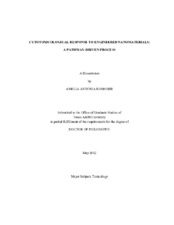| dc.description.abstract | Nanoparticles, while included in a growing number of consumer products, may pose risks to human health due to heavy metal leaching and/or the production of reactive oxygen species following exposures. Subcellular mechanisms of action triggered as a result of exposure to various nanoparticles are still largely unexplored. In this work, an effort to elucidate such toxicological parameters was accomplished by evaluating oxidative stress generation, changes in gene and protein expression, and cell cycle status after low-dose exposures to a variety of metal and carbon-based nanomaterials in primary human dermal cells. Additionally, mitigation of nanoparticle toxicity via microencapsulation was investigated to assess the feasibility of utilizing nanomaterials in dermally implantable biosensor applications.
Cellular immune and inflammatory processes were measured via qPCR and immunoblotting, which revealed gene and protein expression modulation along the NF-kappaB pathway after a variety of nanoparticle exposures. The role of immunoregulatory transcription factor NF-kappaB was examined in an oxidative stress context in cells exposed to a panel of nanoparticles, whereby glutathione conversion and modulation of oxidative stress proteins in normal and NF-kappaB knockdown human dermal fibroblasts were monitored. Results revealed decreased antioxidant response and corresponding increased levels of oxidative stress and cell death in exposed normal cells, compared to NF-kappaB incompetent cells. However, reactive oxygen species production was not an absolute precursor to DNA damage, which was measured by the comet assay, gamma-H2AX expression, and flow cytometry. Protein analysis revealed that map kinase p38, rather than p53, was involved in the halting of the cell cycle in S-phase after ZnO exposures, which caused DNA double strand breaks.
Microencapsulation of fluorescent quantum dot nanoparticles, specifically, was utilized as a method to improve system functionality and surrounding cellular viability for the purpose of a dermal analyte detection assay. In vitro results indicated a functional localization of nanoparticles, as well as cessation of cellular uptake. Subsequently, cellular metabolism was unaffected over the range of time and concentrations tested in comparison to unencapsulated quantum dot treatments, indicating the usefulness of this technique in developing nanoparticle-driven biomedical applications. | en |


